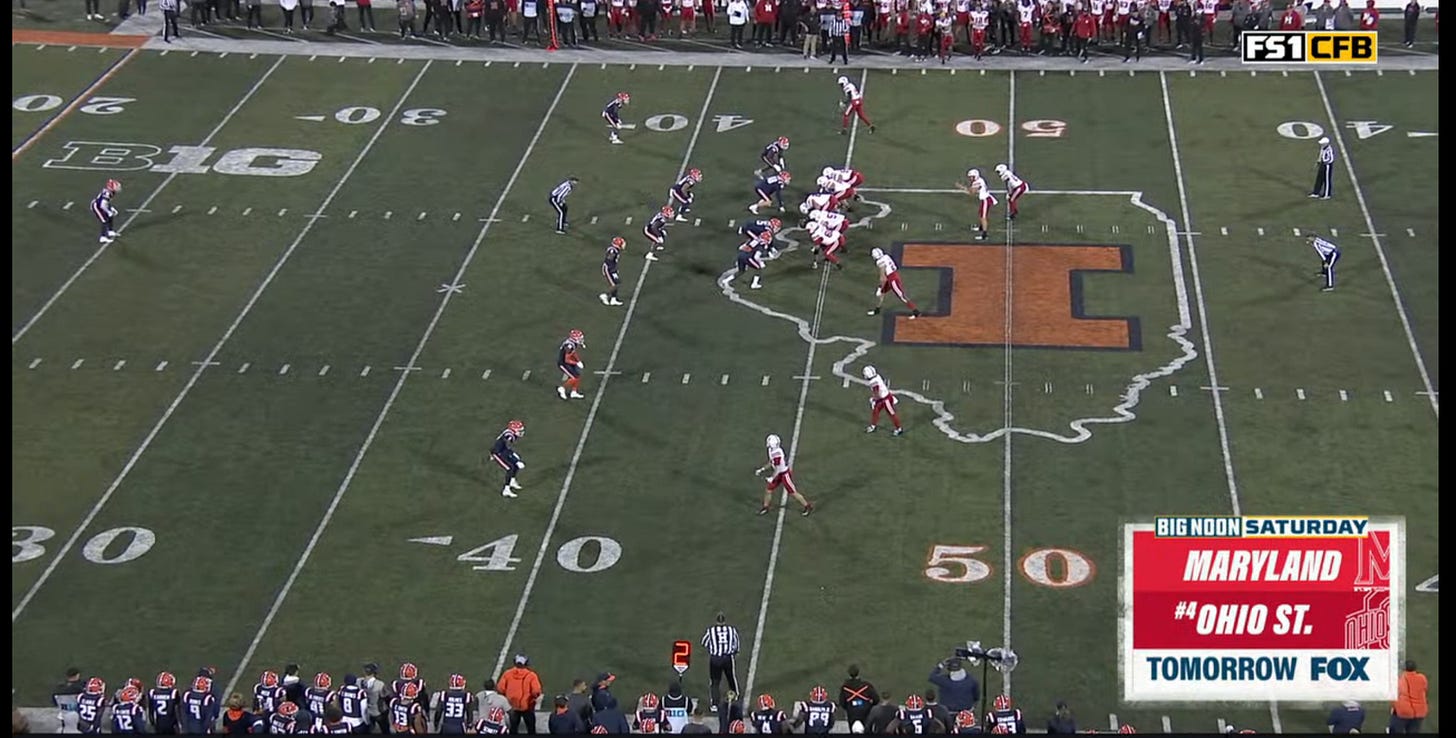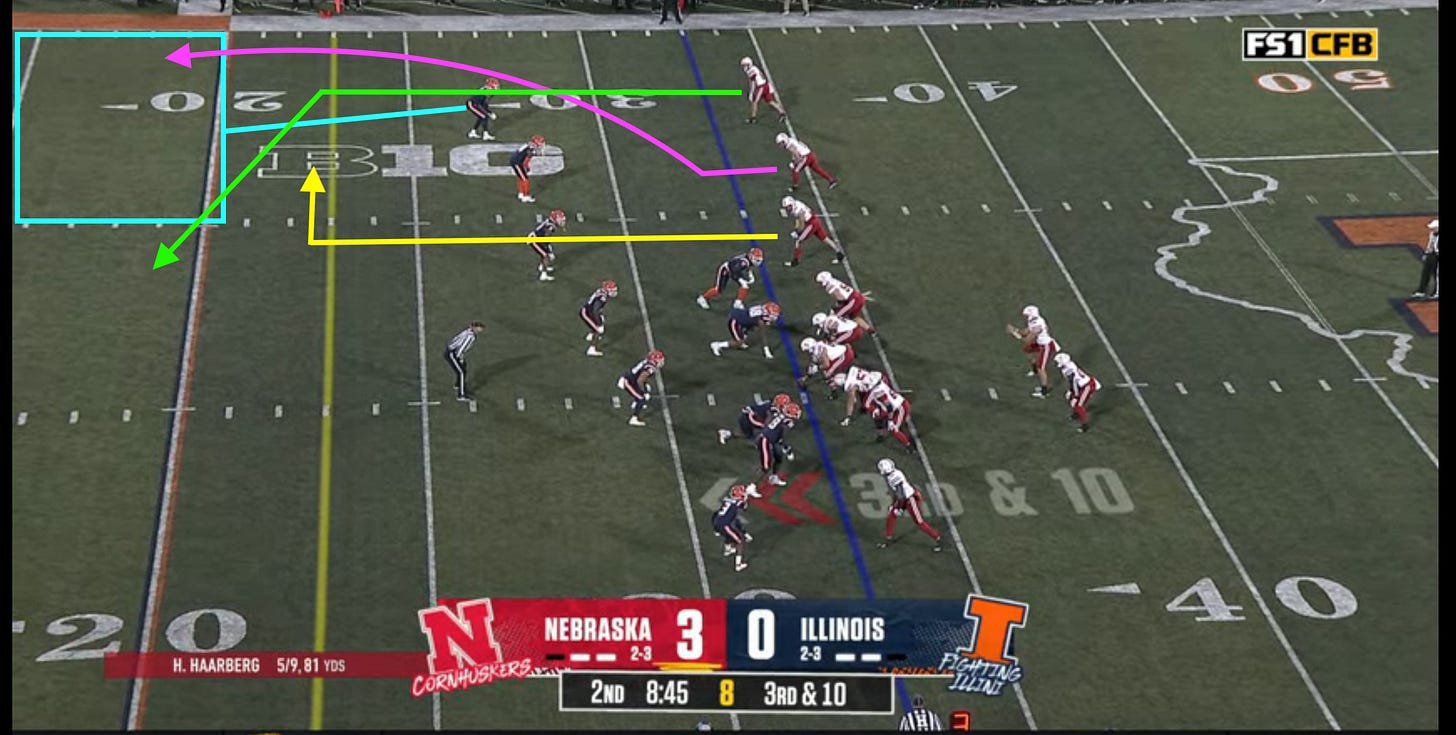OFFENSIVE RECAP: 2023 Illinois
Marcus Satterfield: "It's Trap time"
Glossary of Terms1
Link to Charting Sheet2
Drive 1
10 Plays, 9.1 Yards Per Play
40% Success Rate
3 Explosive Plays, 0 Havoc Plays
Starting inside its own 1 yard line, the Huskers go 91 yards on a long drive with only four succesful plays. Explosiveness rocks!
After an initial quarterback sneak to get some space, coordinator Marcus Satterfield makes a pretty aggressive call from the shadow of his own endzone, calling a deep-drop, downfield “989” concept, with quarterback Heinrich Haarberg finding receiver Marcus Washington downfield one-on-one against Cover 3 on a back-shoulder ball for a 39-yard gain. That alignment would be Illinois’ go-to. Its gameplan throughout almost all of Friday was this:
A heavy five-man Bear/Penny front no matter the offensive formation to stop the run (sometimes with even a couple linebackers walked down), tight coverage on the outside, and a safety at extreme depth3 to prevent/scare off big passing plays. Illinois would spend nearly all of the game in single-high safety structures (92.7% of its snaps) to get more guys in the box to stop the run (“heavy” boxes on 78.3% of its snaps), and blitz a ton (blitzes on nearly 40% of its snaps), but that also led to really favorable matchups on the outside, if NU’s receivers could take advantage of them. The Huskers receiving talent often, couldn’t, but this was one example.
NU gets another first down on an option play where it reads the Illinois’ 3 technique, then a short run and a 21-yard explosive completion to tight end Thomas Fidone off a Post-Wheel trips concept that was used frequently throughout the first half to beat Illinois’ Cover 3 (I diagram that play later when we get a better camera view). On the 3-tech read play, eliminating Illinois’ interior linemen was also a big part of Satterfield’s gameplan — Illinois tackles Jer’Zhan Newton and Keith Randolph Jr. are probably both top 100 NFL picks soon — with NU running plays where read or trapped an interior lineman on 14.5% of its total snaps. It’s season average had been 1.7% entering the game.
Now on Illinois’ side of the field, Satterfield begins one of the strangest playcalling sequences of Nebraska’s season so far. NU debuts a new play, a variation off a run concept called Trap4:
The goal of a Trap concept is to leave an interior defensive linemen unblocked at the start of the play, allowing them to get upfield penetration at the snap, before an offensive lineman from the other side of the formation comes across and seals them upfield, using the defensive lineman’s forward momentum to run them out of the play and give the back a seam up the middle. In this particular variation of the play, the “trapper” lineman is not a lineman at all but instead the motioning-in tight end from the slot (green), with the line dividing 4-to-1 to allow the Illinois 3 tech (blue) to get upfield, before he’s sealed off:
This was a new design I haven’t seen NU run, and I imagine they came up with it this week to combat Newton and Randolph. It clearly catches Illinois off-guard, too, as the defensive tackle runs himself out of the play, and tailback Anthony Grant is able to pick up 12 yards on the run. Not bad!
Now it gets weird. Satterfield call a variation of this play three more times in a row (four times in a row total), with the same motion, and the Illinois defense increasingly going, “We know you’re running this,” and shutting the plays down:
On the first play in the video above, the change on the first play is that Satterfield uses a different formation, running the Trap out of a wide doubles open look. The initial 12-yard run off it came out of wide trips.
On the next snap, the variation is the motion and adding a read; the motioning-in tight end stops at the wing instead of getting a running start into the d-tackle, and bypasses blocking the tackle to get to the second level. This lets Haarberg read the Illinois player, giving the ball to Grant when the DT shuffles down on Haarberg.
And finally, on the last rep, NU changes the defensive player its trapping, letting the boundary edge defender get the penetration before being sealed off.
NU would run some variation off this Y Trap concept on 11 plays Friday, 15.9% of its total snaps. It had previously used Trap concepts on just 1.69% of its total *run* concepts entering this game, just two total snaps in the first five games. Friday’s plays would be successful just five times, but they did deliver gains of 12, 10, 7, 6, and 5 and convert a key third down on a night moving the ball was difficult.
Drive 2
3 Plays, 2.0 Yards Per Play
0% Success Rate
0 Explosive Plays, 0 Havoc Plays Allowed
Nebraska’s second drive is a lot less successful than the first but had the chance to be more. On first down, wide receiver turned running back Joshua Fleeks subs in for a counter play, the concept he took 75 yards for a score last week, but this week bounces outside the running lane for a short gain. Illinois is out of the bear front but still plays with seven players in the box. After a second false start penalty, Satterfield spreads the defense out on second down with an empty package, but Haarberg bails on the Post-Wheel concept with the #3 on an out route to scramble just before Fidone breaks open. On third down, Illinois lines up in a heavy pressure package and brings six rushers, causing Haarberg to take a goofy sprint dropback that messes up the timing of a Mesh play that was in a favorable look against man coverage. It’s good the young quarterback was able to recognize the blitz before the snap, but bailing the way he did automatically turned things into scramble-around ball and didn’t give him a chance to get the ball in a playmaker’s hands downfield.
Drive 3
14 Plays, 4.6 Yards Per Play
42.9% Success Rate
1 Explosive Play, 1 Havoc Play Allowed
The Huskers embark on their longest drive of the season to this point, using a fourth-down and third-and-long conversion to go 79 yards for a touchdown and a multi-score lead. NU opens the drive in an unbalanced quads formation, with Haarberg keeping around the end on an Arc-block read-option play. This was a big unbalanced-usage game; Nebraska entered averaging 4.08% of its snaps in unbalanced and went 7.2% on Friday.
Satterfield now begins trying to exploit the Illinois’ defense’s aggressiveness on the Trap play from the first drive, first on a glance-route play-action pass to the slot off the divide blocking scheme to the slot receiver:
This sort of looks like an RPO, but Haarberg doesn’t seem to be reading anything immediately and the backfield action seems more like a token fake than a true option to handoff, which makes it seem like more a designed play-action to me. Either way, the post route clears when the front collapses down to fill the run as it sees the Trap blocking scheme and Billy Kemp IV’s bubble route pulls the No. 3 defender to the sideline.
After two more short runs (one of which has a 15-yard facemask penalty tacked onto the end) and a deep, two-man-route play-action shot out of the I formation that Illinois gloves up, Nebraska runs another pass off the Trap play, with Haarberg whipping the ball out to true freshman Malachi Coleman for his first career catch on a quick-out RPO:
This is a leverage RPO, meaning Haarberg has the option to throw this out based off the pre-snap look, should the Illinois cornerback be playing off coverage. It’s a simplified read. Once the defense gets the motion Y Jet motion in from the tight end that has been happening for the Trap play, the front shifts down on the run, and Illinois also has a blitz on. Teams are a lot less likely to press when blitzing to avoid getting beat and giving up a huge play.
On the next snap, Satterfield again tries to attack Illinois’ Cover 3 with the Post-Wheel route combo for the fourth time in the opening 22 plays (and fourth in seven true pass drop-backs), this time on an unbalanced formation fake Jet Sweep, with the running back coming out of the backfield on the wheel to the non-unbalanced side of the formation:
Haarberg puts a floating pass on this instead of firing in a bullet up the sideline, resulting in an incompletion, but the concept worked again to spring a receiver open. To this point in the game, Illinois has been in a single-high safety coverage shell on all but two of its plays and playing Cover 3 on most of its snaps. This is a great rep to see how the post route breaking to the middle of the field next to the sideline wheel route puts the outside zone defender in conflict.
Now in third-and-long … Satterfield calls Post-Wheel again, this time resulting in a chunk play that gets Nebraska in the redzone:
This rep provides a great view to explain how the concept creates a “one defender has to cover two receivers” conflict and stretch on the outside zone defender in Cover 3:
The defender (in blue) is responsible for any vertical route that challenges him deep in the outside third of the field. This concept is essentially flooding that zone with two routes and pulling him in two different directions. To the middle of the field with the outside post (in green) and to the sideline with the No. 2 wheel (purple). Whichever he chooses, the other will be open. Additionally, the deep out route from the No. 3 receiver (yellow) ties down the underneath defender to that side and prevents them from dropping deeper to help the corner.
Keep reading with a 7-day free trial
Subscribe to Black 41 Flash Reverse to keep reading this post and get 7 days of free access to the full post archives.






